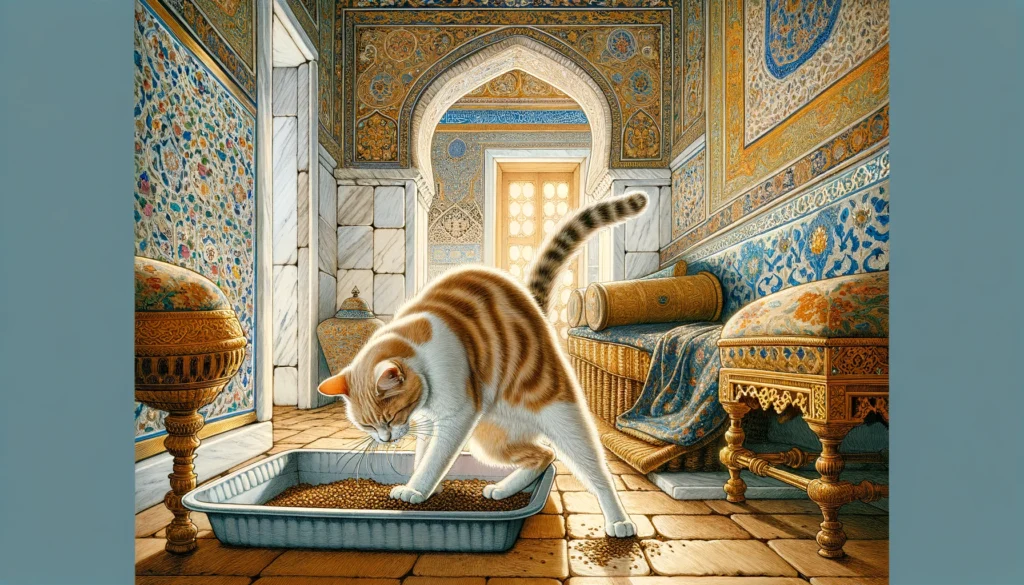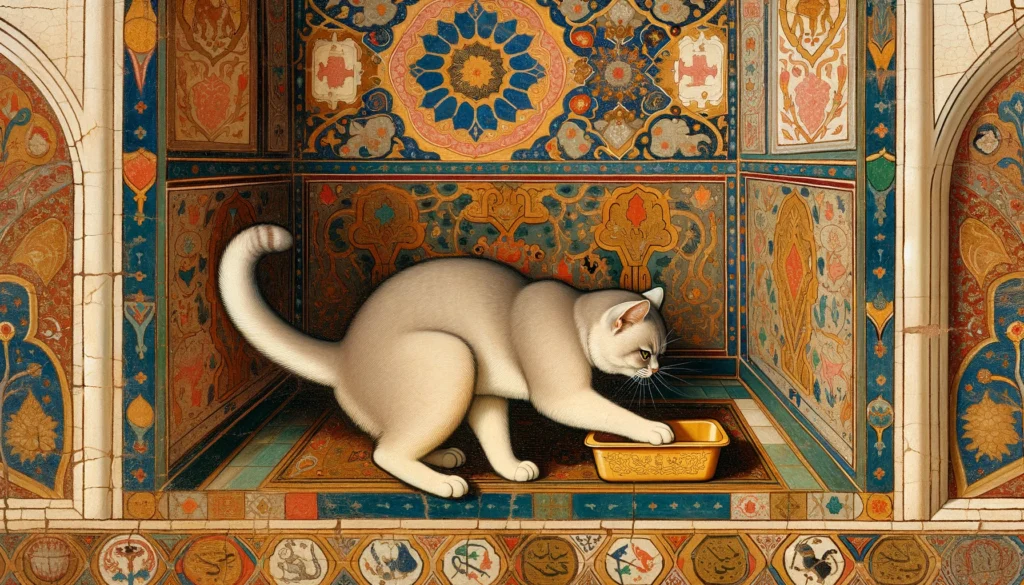Have you ever noticed your cat scratching the side of their litter box? In this article we’ll get to the bottom of it and find out why do cats scratch the side of the litter box, which is actually quite a common feline act.
Cats engage in this activity not just for fun but because it’s part of their instinctual behavior related to cat litter cleanliness and territory marking. Scratching helps cats keep their space clean and mark it as theirs.
Why do they do it? Here are a few tips and tricks you can try if you feel your kitty is maybe scratching a little too much:
- Offer multiple scratching options: Provide alternatives like scratching posts or mats.
- Keep the litter box clean: A tidy litter box is less likely to be scratched at excessively.
- Observe and adjust: Notice if the scratching decreases with changes in the litter type or box location.
Cats’ litter box scratching is a blend of instinct, communication, and personal preference. By addressing these aspects, you can help your cat feel more at ease and possibly reduce unwanted scratching.
This fun, easy-to-digest guide will walk you through the basics of feline litter box behavior, diving into the reasons behind it and how you can create a more harmonious living situation for both you and your furry friend.
Key Takeaways: Understanding Your Cat’s Litter Box Behavior
- Cats scratch the sides of their litter boxes due to instinctual behaviors, including marking territory and maintaining cleanliness.
- Choosing the right litter box and maintaining its cleanliness are essential to prevent unwanted scratching and ensure your cat’s comfort.
- Providing alternative scratching options like posts and toys can help divert your cat’s natural scratching behavior away from the litter box.
- Regular observation and adaptation to your cat’s preferences and behaviors are crucial for a happy, stress-free pet.
Your cat’s likey not trying to burrow to China. Find out 5 Reasons Why Cats Dig in the Litter Box
The Basics of Cat Litter Box Behavior
Understanding why cats scratch the sides of their litter boxes begins with the basics of feline instinct and litter box habits.
- Cats cover their waste to hide their scent from predators and rivals.
- The texture of the litter can impact how much your cat enjoys using the box.
- Location is key; cats prefer a quiet, accessible spot that provides privacy.
- Regular cleaning keeps the box inviting and prevents your cat from seeking other spots.
Instinctual Behaviors and Litter Box Use
Cats’ natural instincts drive much of their behavior, including their litter box habits.
- Scratching and burying are natural ways to secure territory and feel safe.
- They prefer a clean area to avoid smells that attract predators.
- A well-maintained box satisfies their need for cleanliness and territorial marking.
Choosing the Right Litter Box
The type and location of a litter box can significantly affect your cat’s comfort and behavior.
- Size matters: Bigger is often better, giving them plenty of room.
- Privacy preferences vary; some cats like covers, while others don’t.
- The box’s location should be quiet yet easily reachable to encourage use.
- Multiple boxes can prevent conflicts in multi-cat households and offer options.

Key Reasons Behind Litter Box Scratching
Several factors contribute to why felines scratch the edges of their sandboxes, from natural instincts to environmental triggers.
- Scratching can also help keep their nails in great shape.
- It’s their way of stressing less; it’s kind of like yoga for cats!
- Sometimes, it’s just because the texture feels fascinating under their paws.
- They might also be trying out a new litter type or disagreeing with the scent.
Marking Territory and Communication
Scratching is a way for cats to mark their territory and communicate with other pets in the household.
- They leave both a visual mark and a scent to say, “Hey, this is my spot!”
- It’s like their version of social media—but with more scratching and less scrolling.
- New pets in the home can trigger more scratching as a way to establish boundaries.
Cleanliness and Comfort
A clean, accessible litter box is crucial for your cat’s comfort and can reduce unwanted scratching.
- Cats are clean freaks; a dirty litter box might lead them to “remodel” the area.
- They prefer a spot that doesn’t trap them or make them feel vulnerable.
- Ensuring the litter box is easy to enter and exit can make a big difference.
- Sometimes, switching up the litter to a finer, sand-like texture helps too.
Addressing Litter Box Scratching
Once you understand what makes cats scrape the perimeter of their litter containers, you can take steps to mitigate this behavior.
- Observing your cat’s litter box usage can provide insights into their preferences.
- A bit of detective work to find the perfect litter type and box location can go a long way.
- Regularly updating your litter box setup based on your cat’s behavior keeps them happy.
- Remember, a happy cat equals a scratch-free litter box (well, almost!).
Improving Litter Box Conditions
Regular cleaning and choosing the right litter can make the litter box more appealing to your cat.
- Cleanliness is next to catliness: Scoop daily and deep clean weekly.
- Experiment with different litter types; your cat might prefer clumping, paper, or even silica gel.
- Location, location, location: Keep the box in a quiet, accessible spot, away from busy areas.
- Consider a litter box with higher sides to minimize litter scatter and provide privacy.
Alternative Scratching Solutions
Providing alternative scratching options, like posts and toys, can divert your cat’s attention away from the litter box.
- Scratching posts and pads can be a great outlet for their natural instincts.
- Interactive toys keep them engaged and away from the litter box when it’s not bathroom time.
- Placing catnip near these alternatives can attract them to scratch there instead.
- Remember, variety is the spice of life for cats too; rotating toys and scratchers keeps things interesting.

Frequently Asked Questions
Q: Why do cats scratch the side of the litter box?
A: Cats scratch the side of the litter box primarily as a natural instinct to mark their territory and maintain their claw health. This behavior also helps them express their feelings about the litter box environment, whether it’s discomfort with the litter or a way to cover up after using it.
Q: Is scratching the side of the litter box a sign of cat stress?
A: Yes, scratching the side of the litter box can sometimes indicate stress or anxiety in cats. If this behavior is accompanied by other changes in habits or demeanor, it might be a sign that the cat is feeling uneasy or stressed.
Q: How can I stop my cat from scratching the litter box sides?
A: To discourage your cat from scratching the sides of the litter box, consider providing alternative scratching surfaces like scratching posts or pads. Ensuring the litter box is clean, spacious, and filled with comfortable litter can also help reduce this behavior.
Q: Does the type of cat litter affect scratching behavior?
A: The type of cat litter can indeed affect a cat’s scratching behavior. Cats may scratch more if the litter is uncomfortable for their paws or if they dislike the texture or scent, so finding a litter that your cat prefers might reduce scratching.
Further Reading
My Cat Is Scratching Their Litter Box Excessively: 8 Reasons & How to Stop It
Why Does My Cat Scratch The Sides Of The Litter Box
Why Cats Scratch, Dig & Play in Their Litter Box
Wrapping It Up: A Scratch-Free Future
By addressing the root causes of why do cats scratch the side of the litter box, you can improve your cat’s litter box experience and maintain a peaceful home. Remember, understanding your furry friend’s behavior and needs is key to a happy cat and a happy home.
- Keep the litter box clean and inviting.
- Offer plenty of scratching alternatives.
- Pay attention to your cat’s habits and preferences.
- Be ready to adjust your strategy as your cat grows and changes.
Understanding why cats scratch the side of the litter box isn’t just about solving a nuisance; it’s about creating a comfortable and stress-free environment for your beloved pet.
So, what steps will you take today to ensure a happier litter box experience for your cat?


